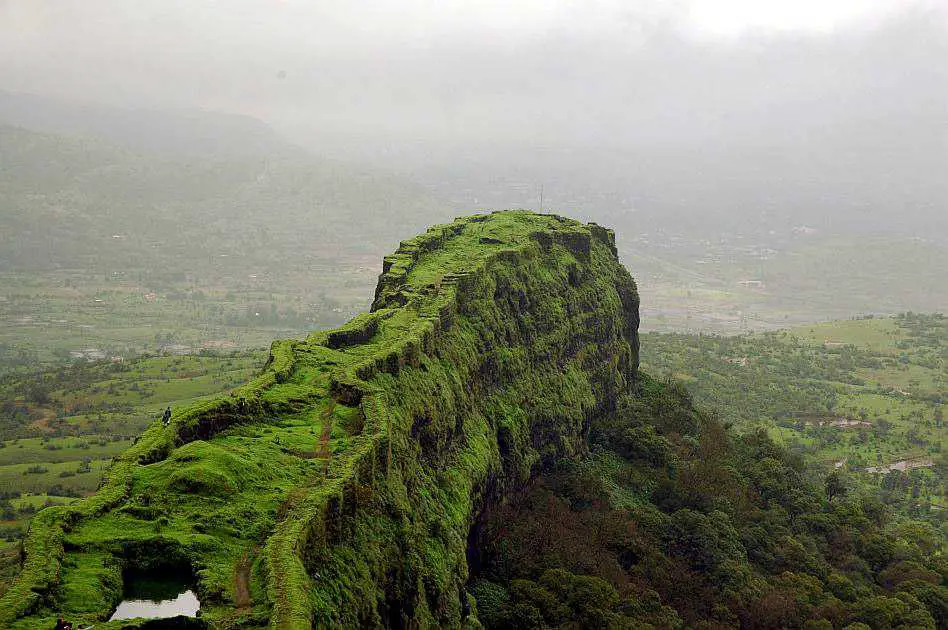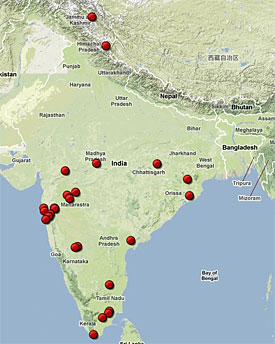World 🢖 Asia 🢖 India 🢖 Maharashtra
Buddhist shrines 🢔 Religious architecture 🢔 Archaeological wonders 🢔 Categories of wonders
Wonder
Manmod Caves, Junnar
 In short
In short
Area around Junnar contains more than 200 ancient rock-cut temples. Main four groups of these temples are Manmod Caves to the south-east, Shivner Caves to the south-west, Tulja Lena to the west and Lenyadri Caves to the north.
 42.8%
42.8%
GPS coordinates
Location, address
Alternate names
Age
Religion
Map of the site
If you see this after your page is loaded completely, leafletJS files are missing.
 In detail
In detail
Temples of merchant centre
Junnar was an important trade center in the 1st century AD, controlling a trade route that led from Satavahana capital Paithan to the rich ports at the Arabian Sea. The route was busy transporting carnelian and textiles to the Middle East and Roman Empire, the path was often made also by ancient Greek and Middle East traders.
Manmod caves – Buddhist monasteries – have been created approximately 2000 years ago, in the 1st – 3rd century AD, they were designed after Hinayana canons. Caves were created in three compact groups. Easternmost is Bhimashankar Group (10 caves), in the middle is Ambika Group (19 caves), and closer to Junnar, more to the north-west is Bhutling Group (16 caves).
Bhimasankar Group
Bhimasankar Caves are looking east, towards Dudhare Hill.
- Cave I – monk’s dwelling (layana). Consists of verandah and three separate cells behind verandah. Nearby are remnants of a similar unnumbered cave.
- Cave II – planned as shrine (chaitya) but during the works a fracture was reached and works at shrine abandoned. Verandah with two pillars. Unfinished sculpture of seated women.
The cave contains remnants of plaster (possibly made of rice chaff and clay) and painting on the ceiling of the hall and verandah. Seems that there were painted circles, used red yellow, and white colors, painting leaves an impression of bad quality work.
Remnants of inscription left by donor – some merchant. - Cave III – consists of verandah and inner hall. Possibly this was dining hall. In the front of cave cistern filled with earth and trace of another cistern.
- Cave IV – vihara, consists of verandah with two pillars and cell. Not finished due to bad condition of rock.
- Cave V – just artificially made opening, possibly, unfinished cistern. Contains inscription left by donor. Another cistern nearby.
- Cave VI – mandap, chamber for rest. Inscription on the wall, left by the donor of this cave and cistern – prime minister Ayama, served for king Nahapana, 124 AD.
- Cave VII – small vihara.
- Cave VIII – row of seven cells.
- Cave IX – hall with forecourt. Possibly – dining hall. Remnants of cisterns near it.
- Cave X – vihara, consists of verandah and incomplete cell.
Ambika Group
Named after a sculpture of Jain goddess Ambika in Cave XVI. These caves are located some 250 m north from Bhimasankar Group. These caves face to nort-north-east. Near these caves there are seven cisterns, some hold water up to this day.
- Cave XI – small vihara, partly collapsed.
- Cave XII – unfinished vihara. Verandah is finished but two cells are not.
- Cave XIII – vihara, consists of cell and verandah, partly collapsed.
- Cave XIV – vihara, consists of main hall and two ceils, one in each side of hall. Partly collapsed. Contains inscription left by donors – two sons of some houseowner.
- Cave XV – large cell, possibly used to keep cattle.
- Cave XVI – Jain monastery, possibly converted for Jains in the 10th – 11th century AD. Carving of Jain goddess Ambika. Large verandah and five cells. Contain some more Jain stone carvings – Kshetrapal woth human and dog from the 10th – 11th century. Image broken, possibly by Muslim believers. Broken sculpture of goddess Chakreshvar, Tirthankars Neminath and Adinath and other sculptures. Cave contains traces of plaster from the 10th – 11th century, made of plant fibres and lime.
- Cave XVII – cell.
- Cave XVIII – two collapsed cells.
- Cave XIX – collapsed, consisted of verandah and cell.
- Cave XX – small, quadrangular chapel. Could be made around 50 AD and dedicated to some local monk.
- Cave XXI – unfinished shrine, chaitya, intened as the main shrine in this group of caves. Unfortunately builders met a layer of soft rock and thus had to abandon their work. Verandah with two pillars and two pilasters in Shatakarni style (90 BC – 300 AD).
Verandah contains 11 inscriptions – left by donors to this group. Possibly this cave was used for such inscriptions because it was standing empty and without use – thus accessible to anyone. One of inscriptions is left by Aduthuma, Parthian Greek convert to Buddhism. Another is Persian inscription from 1580 AD, left by some visitor Mahammad Ali. - Cave XXII – well made vihara, dwelling of monks. Consists of verandah and two cells. Inscription left by donors – brothers Budhamita and Budharakhita.
- Cave XXIII – consists of verandah and two cells. Inscription left by donor – housekeeper Sivadasa.
- Cave XXIV – planned as vihara, only verandah completed. Contains inscription with swastika at the end of text. Thus it shows that inscription of donation possibly was left already at the start of works.
- Cave XXV – unfinished verandah with two pillars and two pilasters.
- Cave XXVI – unfinished cave, verandah with two pillars and two pilasters.
- Cave XXVII – vihara, two cells and verandah formed like recess.
- Cave XXVIII – small dwelling – small verandah with a cell.
- Cave XXIX – unfinished cave, verandah with two pillars and two pilasters. Several rock-cut cisterns.
Bhutling Group
Bhutling group os some 200 m to the north-west from Ambika Group. Caves face to north-east.
- Cave XXX – vihara, not finished due to leak of water from above.
- Cave XXXI – dwelling, consists of single cell.
- Cave XXXII – dwelling with four cells. Structure is in bad condition, partly filled with earth.
- Cave XXXIII – vihara, consists of verandah, hall and seven cells. Not finished.
- Cave XXXIV – vihara, consists of verandah with four cells.
- Cave XXXV – vihara, consists of verandah, hall and one cell in rear wall.
- Cave XXXVI – vihara, consists of verandah with four cells. Each cell is entered through a door with horseshoe arch. Interior is adorned with reliefs including Buddhist wheel. Also here in 1580 AD the Persian traveller Mahammad Ali has left an inscription.
- Cave XXXVII – simple cell.
- Cave XXXVIII – unfinished chapel, the largest structure in this group. Cave is 9 m long. Much of cave is filled with soil. Terrace above the verandah is ornamented with a group, consisting of Lakshmi and lotus flower and leaf, elephants and other figures. Cave contains inscription left by donor.
- Cave XXXIX – vihara, consists of partly collapsed verandah and cell.
- Cave XL – partly collapsed, only cell remains, with earth-filled cistern in front.
Next five caves are somewhat further away, across a small glen.
- Cave XLI – small, unfinished cell.
- Cave XLII – verandah with unfinished cell.
- Cave XLIII – unfinished cell.
- Cave XLIV – dwelling, consists of verandah and cell.
- Cave XLV – located in some distance from others. Unfinished cell.
References
- Junnar, Maharashtra Gazetteers Department, accessed on May 30, 2010.
- Lenyadri Group of Caves, Junnar, Archaeological Survey of India, accessed on May 30, 2010.
- Manmodi Group, Junnar, gallery by Sujay, Picasa. Accessed on May 30, 2010.
Manmod Caves, Junnar are included in the following article:
 Linked articles
Linked articles

Wonders of India
India is the seventh-largest country in the world by area, and, naturally, such a large area contains a huge amount of exciting attractions…
Wondermondo considers that India is the second richest center of architectural heritage in the world after Europe and maybe no single country in the world can match it in this respect.

Wonders of Maharashtra
Maharashtra is a truly splendid state. It has everything – enormous metropolises and countless waterfalls in mountains, urban decay, and architectural splendor, remnants of millennia-old Harappan towns, and modern, very expensive architecture.

Buddhist shrines
Buddhism is one of the world religions and at the same time is a spiritual philosophy with diverse traditions, beliefs, and practices. There exists a rich tradition of architecture expressed in Buddhist temples and monasteries.
 Recommended books
Recommended books
India Unveiled: Spirit, Tradition, People
This is the one book you need to understand the spirit of India. Internationally acclaimed as the best book of its type on India, this sixth expanded, revised edition of the multi-award-winning book India Unveiled: Spirit, Tradition, People by Robert Arnett truly reveals the diversity and sacredness of the oldest continuously living civilization on earth.
India: A Sacred Geography
A spiritual history of the world’s most religiously complex and diverse society, from one of Harvard’s most respected scholars.



